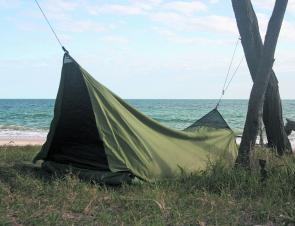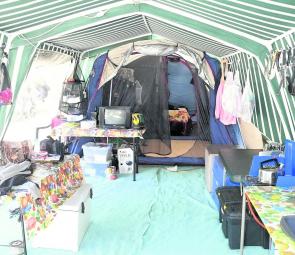Fraser Island, about three hours north of Brisbane and 15km off the coast of Hervey Bay and Maryborough, is the largest sand island in the world, and a popular location for sightseers, campers, 4WDers and anglers. I’ve been visiting Fraser with family and friends for over 25 years, and I believe it lives up to the name given to it by its original indigenous inhabitants: K’Gari, meaning paradise.
Its exceptional beauty is made up of a collision of miles of white sandy beaches, striking coloured sand cliffs, towering rocky headlands, ancient rainforests, a hundred lakes that range from tannin-stained to crystal clear, along with a mix of vegetation, wildflowers and wildlife. All of this combines to give Fraser Island its World Heritage listing, alongside the likes of Uluru, Kakadu and the Great Barrier Reef. It’s a place that everyone should visit at least once in their lifetime. You can day trip to the island, self-guided or on a commercial tour, but most people choose to stay a while and take in more of the sights.
Fraser’s attractions are many and varied, but it’s the fishing that draws many of us back again and again. The winter tailor run sees a migration of anglers to the island, but there are so many more species on offer, including whiting, dart, bream, flathead, trevally, queenfish, kingfish, mackerel and tuna for shore-based anglers. There’s also a wide range of reef and pelagic species for those anglers launching boats off the beach.
Please remember that as a visitor to Fraser Island you have an obligation to understand the rules and regulations that are in place for the safety of yourself, others and for the sustainable management of this magnificent environment. You can get maps, detailed information, permits and more online from www.nprsr.qld.gov.au/parks/fraser .
Vehicle access to the island is via barge from one of two locations. The first is Inskip Point, 15 minutes from Rainbow Beach. It takes 10 minutes to arrive at Hook Point on the southern tip of the island and no booking is required.
The second option is the barge from River Heads, which must be booked and takes about 30-50 minutes to drop you on the island at Wanggoolba Creek and Kingfisher Bay.
A vehicle access permit is required and must be displayed on the windscreen of your vehicle. It’s available for purchase online, over the counter or by phone.
Resort accommodation is on offer on the inside of the island at Kingfisher Bay Resort, or on the main surf beach at Eurong Beach Resort. If a house, cabin or unit is your preferred option there’s a range to choose from, spaced out at various population hubs along the surf side of the island at Happy Valley, Eurong, Poyungan Rocks, Yidney Rocks, Cathedral Beach and more. From here it is through the sand blow at the iconic Indian Head and on to Orchid Beach, which has plenty of rental houses for holidaymakers.
For most people who visit Fraser Island though, their accommodation will be camping and their home base a swag, tent or off-road camper trailer. The Queensland Parks and Wildlife Service (QPWS) manages a number of formal campgrounds which are popular with families with small children. You can also choose from 23 less formal beach campgrounds (not including walkers’ camps), which are also managed by the QPWS. There are too many individual campsites to list here, but each is described in detail on the website mentioned above. The website includes info on facilities, locations, access, number of sites, campsite surface, fires, generators and essentials to bring.
All formal camp areas have defined (but not numbered) campsites, water taps or tap stations, toilets, 9pm noise curfew and no generators. Most formal camp areas have dingo-deterrent fences, gas BBQs, deep sinks for washing dishes, coin-operated showers and information displays.
Informal camp areas have a large open area behind the foredunes with no defined sites, set limits defined by signposts, vehicle access tracks to and from the beach and boat access for some sites. There is a ‘generators permitted’ rule (etiquette is 9am-9pm use), ‘no fires’ rule, no noise curfews, no toilets (best bring a portable toilet), no water and no bins.
Most campsites are on a sandy and grassy surface, with reasonable shade and privacy supplied by natural vegetation. Remember this is beach camping so ensure you have sand pegs. It’s also a good idea to throw in a few spare pegs, ropes, poles and tarps so that you can deal with changes in weather conditions. Note that ropes cannot be tied to trees.
A bit of research will assist you in selecting a campground close to the sites you want to see, or areas that you wish to fish, remembering that vehicle travel is often restricted to the lower half of the tides. Popular campgrounds during the annual tailor run (which is when many anglers fish areas from Cathedral Beach to Ngkala Rocks at the northern end of the island) include Dundubara, Cathedral Beach and Waddy Point.
If you’re more interested in the lakes and walking trails you might want to camp further down the island to avoid longer drives and maximise the time you can spend exploring. On the northern tip of the island, about 35km from the northernmost settlement of Orchid Beach is Caree campground, where I have spent many of my trips. This is a magnificent location but it’s considered semi-remote. You are completely cut off on the top half of the tide and there are no facilities, so you need to take all of your food, water, toilet and shower facilities, fuel and so forth with you. This area is best visited by experienced 4WDers and campers.
Camping permits are available online, over the counter and by phone, with permits required for all camping on Fraser Island, except the privately run camping areas at Dilli Village, K’gari Facility and Cathedral Beach. Permits can be purchased up to six months in advance, and once you’re set up you need to display your permit clearly on your campsite for visiting rangers to check. The cost per night for Parks and Wildlife Services run campgrounds is well under $10 per person, making for an inexpensive holiday in an incredible location. Group campsites for larger groups are also available at some campgrounds.
I have seen dingoes on every trip to the island and it’s important to remember that these are wild animals. Do not feed dingoes or leave scraps out for them. Dingoes will generally keep their distance unless attracted by food. Your permits and map will come with ‘dingo safe’ information that you should read, but some tips include keeping children within arm’s reach, walking in groups, avoiding jogging or running (this can incite a negative response), keeping your food and icebox locked up and not in your tent, and securing all rubbish, bait and fish.
Most townships have dingo-deterrent fencing, and several camp areas have dingo fencing with gates. These locations are recommended for families with children under 14 years of age.
I am yet to have a negative experience with dingoes on the island, but I’m always aware of their presence and don’t put myself in a situation that may put me at risk.
Bins are provided in close proximity to formal camp areas. If you’re beach camping you should take a bin with a lockable lid to house your rubbish. We add an occy strap to secure the lid to prevent dingos, monitors or other wildlife from raiding it and causing a mess. If you’re camping on the beach you can find fenced rubbish and recycling transfer stations dotted along the beach at several locations marked on island maps.
At each major township you will find fuel (not autogas), ice, gas, takeaway food and general shopping. EFTPOS is available in some locations.
No camp fires are allowed unless in the QPWS provided fire rings at designated campsites. Firewood is not provided and it is illegal to gather firewood in a national park. Bring milled firewood and firelighters if you plan to have a fire in the provided rings.
Fuel stoves can be used for cooking, using gas or the manufacturer’s fuel, not timber or bush wood. Stoves must be a minimum of 20cm from the ground.
Showers are available at formal camp areas. Make sure you bring a bundle of $1 coins with you for a hot shower.
We generally beach camp so we run a simple 12V shower with water preheated on a gas stove for short stays. On longer holidays we use a portable gas shower. Don’t forget a few empty drums or collapsible water containers for shower water, and don’t drink it. All drinking water on the island should be treated before drinking.
Mobile phone coverage can be limited, depending on your provider, so it’s a good idea to pack some 20c and 50c coins in your kit to use the pay phones dotted throughout the island at selected camp areas.
You’re not allowed to use generators in formal camp areas but it’s OK to use them in beach camping areas (unless signed otherwise). Generators up to 2.0Kva and no louder than 65 decibels are allowed, and they may be operated between 9am and 9pm.
There is no fish filleting to be done in campsites, due to the smell and attraction to dingoes and other wildlife. Over the years we have designed a variety of fillet tables that slide out from vehicles, attach to vehicles or free stand, and we generally fillet our fish on the beach during the day with an awning out to create shade. Fish frames and unwanted bait should be buried just below the high tide mark, in a hole about 50cm deep, when dingoes are not present. Remember to check the local bag and possession limits.
Whether it’s the fishing, spectacular natural environment, walking trails, wildlife or something else that brings you to Fraser Island, camping is a great way to immerse yourself in the heart of K’Gari. At night you can drift off to sleep while listening to the soothing sounds of the wave action, then wake up to a sunrise over the water, wander down the beach to catch fresh tailor for breakfast or join in an afternoon beach cricket game. At dinner time you can enjoy an entrée of fresh fish in the smoker or a roast in the camp oven, plus a coldie and maybe sing along to someone strumming a guitar around a fire ring. Or you can go on a 4WD adventure to the northern most point of the largest sand island in the world.
All up, a camping adventure is a great way to spend time with family and friends, and Fraser Island is a location that is pretty hard to beat. My island home is waiting for me… see you on the beach!
Reads: 4220
A basic campsite in the bottom camp at Waddy. Note the fire ring provided by the QPWS.

Set up for four weeks beach camping on Sandy Cape.

A beach camp set up with water drum, gas shower and a couple of toilets.

Camping can be as simple or as involved as you like.

Not a bad view from the camp.

Camping doesn't mean roughing it. Here we’ve set up a home away from home.

A dome tent and a gazebo provides plenty of living area.

A basic camp complete with plenty of fishing rods.

Hot and cold taps and a gas hot water system provides a hot shower anytime.




